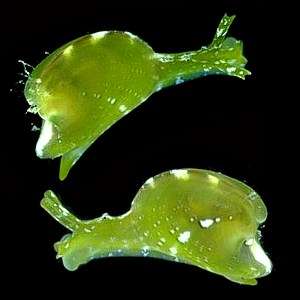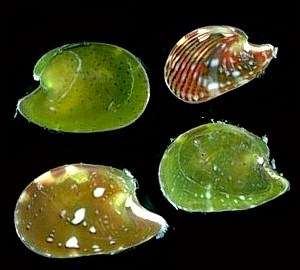The bivalved sacoglossan Julia exquisita
July 21, 1999
From: Bill Rudman


I have posted a page on Julia exquisita, a typical species of the Juliidae, in answer to Grey McNeil's recent enquiry.
PHOTOS: UPPER: Living animals showing typical sacoglossan head and tentacles. LOWER: Differently coloured shells of four animals. Animal approximately 5mm long alive. Koumac, New Caledonia, October 1993. PHOTOS: Bill Rudman.
Julia exquisita is one of a group of remarkable sacoglossan 'snails' which have a bivalve shell. Known only from their fossil shells until a few years ago, they were usually considered to be bivalves rather than gastropods. It is thought that the bivalved shell evolved from a lightly calcified shell like that of Oxynoe or Lobiger.
The shell is more heavily calcified than the species of the Berthellininae and varies in colour from bright green to reddish brown. A pattern of radiating spots and lines can be present on the shell and can consist of white spots or darker shades of the background colour. It is probable the other species of Julia that have been described are colour forms of this species.
Bill Rudman.
Related messages
-
Julia exquisita found in my tank
From: Andy Jukes, August 14, 2006 -
The bivalved sacoglossan genus Julia in Hawaii
From: Cory Pittman, October 12, 2001 -
Hawaiian Julia exquisita
From: Cory Pittman, October 12, 2001 -
Shell of Julia exquisita
From: Cory Pittman, October 12, 2001
